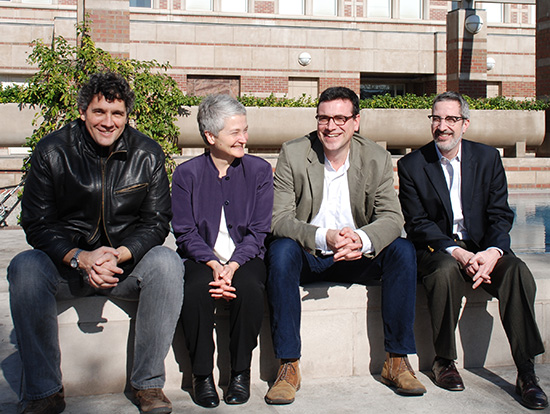Holocaust Geographies Collaborative Returning to USC Shoah Foundation Next Week


From left: Giordano, Knowles, Cole, and Jaskot during their first visit to USC Shoah Foundation in 2014
The four scholars who two years ago found their research transformed by the Visual History Archive will return to USC Shoah Foundation for a public presentation and a week of conducting new research.
Alberto Giordano (Texas State University), Anne Knowles (Middlebury College), Tim Cole (Bristol University), and Paul Jaskot (DePaul University) will conduct research at USC Shoah Foundation January 8-14. They will present the latest developments in their research on Tuesday, January 12 at 4 p.m. in USC Social Sciences room 250.
The Holocaust Geographies Collaborative is a multi-institutional, collaborative nine-member research group that uses mapping and geography to examine spaces and places of the Holocaust. The group came together in 2007 at a workshop hosted by the United States Holocaust Memorial Museum to discuss how geography, mapping and geo-visualization can shed new light on the history of the Holocaust.
In their research, the group creates maps and other visualizations (geographic information science, or GIS) illustrating where events of the Holocaust occurred, where and how people moved from place to place, and other data. For example, the group created an interactive map showing the locations of all the concentration camps in Europe and when they opened and closed over time.
Four members of the group – Giordano, Jaskot, Knowles and Cole – visited USC Shoah Foundation in January 2014 and began exploring the Visual History Archive for the first time. While they expected the testimonies to corroborate research they’ve already done, they were flabbergasted by the personal stories and amount of detail in each testimony, and decided to use testimony to take their research in a new direction.
“We don’t want to write another history of the victims, but rather explore the stories of these individuals and connect that to the big story, to cast a new light on the story,” Cole said. “We want to use the places and spaces as a way to tell new stories of the Holocaust, so suddenly different things become important.”
Like this article? Get our e-newsletter.
Be the first to learn about new articles and personal stories like the one you've just read.